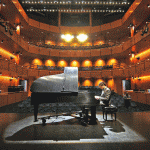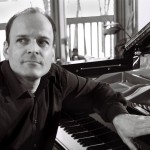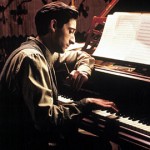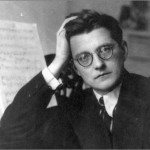At the Tokyo String Quartet’s farewell performance last May, I picked up the Winter 2012 issue of the classical music magazine Listen, which I had just begun to receive gratis for my occasional concert attendance at the 92nd Street Y. It would be mid-summer before I cracked it, and found a short article about the rise of multimedia presentations in classical music venues. Reading it convinced me that I should clarify my own position on the matter by posting an addendum to “The Last Waltzes” (07.01.13), which ended with a kvetch about screens at the Van Cliburn competition. Then, after seeing Lamb of God the other night at the soon-to-be-defunct Roseland Ballroom, it occurred to me that these thoughts might warrant a separate post.
Called “Attack of the Big Screens,” the article (by Colin Eatock) describes the different ways video has been employed in symphony halls around the country—from the naturally spectacular (e.g., NASA images of the solar system to accompany Holst’s The Planets) to more interactive and involved productions, such as those by the CSO’s Gerard McBurney. Reception has been largely positive, at least according to the promoters quoted, while producers and critics alike herald a bright new age. McBurney, for example, sees the screen as a way to help free the symphony hall from the shackles of convention, and audiences of their ossified expectations, “wean[ing them] off one of the great destructive influences of our culture—which is to treat art like something you consume, like a burger and a plate of fries”; and Alex Ross’s claim that the New World Symphony’s production of Thomas Ades’ Polaris convinced him that he was “witnessing the birth of a new artistic genre” suggests the potential of multimedia to transform the contemporary concert experience.
Let me begin by saying that I do privilege “abstract” music, music that is “only about itself” (!?), that eschews visual and narrative programs, and the concert hall as a space to experience music qua music. We don’t need the image of Napoleon on his horse or Obama at his podium to feel our hearts swell, particularly after Waterloo or the ACA. We don’t need NASA images of Jupiter, either, though I’m sure they’re lovely. (No, I’m not going to rehearse the arguments or rebuttals about music deriving its greater power from the absence of such programmatic fixity.)
That said, I have no intention of presenting myself here as another version of the “angry man screaming from the balcony” cited in Eaton’s article—although, it must be said, balconies are fine places to scream from. Marx’s aside, I’ve never been one for manifestos. I can think of nothing more pernicious than an artistic manifesto. Visual media present wonderful possibilities for creating other dimensions in our appreciation of music, and vice-versa, and new aesthetic experiences when combined; the concert hall is a perfect venue for exploring these possibilities; and the music-going public should welcome such productions as they would the opportunity to hear any new work, or new take on a classic work. I would argue that the visual should strive to be an equal partner with the music, as in Ross’s “new genre”: to be more than an embellishment, or a literalizing of the program, if one exists.
Now, the Holst-NASA production may simply make obvious the thinness of the score, and there are certainly pieces like it that beg to be aided by some sort of visual prosthetic.* But the Holst example, unthreatening and dollars-and-cents savvy as it may be, is troubling when considered in the context of a broader, creeping visual parasitism—is troubling precisely because it is unthreatening and easily rationalizable. For such “enhancements” suggest that the musical concert experience is no longer adequate for an audience raised on and mired in visual media; and that this is particularly the case when the music is from another time.
What I object to (as I did at the Cliburn, and might, apparently, in places elsewhere, as smaller, nimbler cities race ahead of my own beloved grey dinosaur) is the injection of the TV aesthetic, its flattening/narrowing of the world, of perception and understanding, into every possible place of assembly. In the ostensibly public spaces of the city, it is obnoxious enough; in concert halls, where people go to physically interact with art and with each other, it is even more disheartening. Lap-space, phone space, iSpace, your space, my space: all are one and equal. Or perhaps not: as every place is re-imagined to accommodate the latest iShit, physical space seems increasingly an adjunct of virtual-cellular space. At a time when I can barely get my students to go hear live music—and who are by and large thankful for the experience when they finally do—articulating the concert hall as another version of the phone/home theater seems like an enormous loss.
I understand that the concert hall is not eternal and immutable, that it is a product of historical forces, that it may soon be another quaint object of nostalgia, like the classroom with the chalkboard and my vaunted public square. And I understand, and don’t regret, that the art-entertainment binary has been paradox’d out of existence over the last half-century. But none of this is an excuse to suspend reflection or judgment. Poetry is still different from advertising; corporations still aren’t people. The composer or visual artist who is inspired to think about how nineteeth- and twentieth-century music or painting responds to and intersects with contemporary culture, and to produce work that, pleasantly or unpleasantly, troubles an audience’s relationship to its culture and its canons, whether by transforming the space of the concert hall or by seeking out some alternative, genre-blending arrangement, is not the same as the bean-counter trying to get more twentysomethings’ butts into seats at Carnegie Hall. Go ahead, tell me about how it was always a business, how Beethoven was a “scheming careerist,” as Virgil Thomson wrote, or how the beboppers wanted not to create a new art form, but get their due as professional musicians, as Scott DeVeaux argued. It’s not purity I want, or its loss I mourn. I’d welcome a bit of dirt in a world where everything is distilled to profit.
Music is one way, maybe the best way, to get outside that. Not to escape it necessarily, but to have a space to reflect, to stand back for a long moment from the hive and the chattering tide, to meet the stranger on the other side of you. And so either there is a sad irony in McBurney’s comment about the screen being a way to wean the public off the idea of art as something to be consumed, or that comment was made in bad faith. Rather than defying expectations, the screen, at least from what I’ve seen, seems like the latest way of giving the people what they want—it’s just different people, with different expectations … the ones who have grown up in the culture of art-as-consumption, and consumption-as-art, and who could most use to have their burgers and fries spilled on them.
*
I don’t have a huge soft spot for the Roseland; it’s always felt more like a wannabe stadium than a big club. That stadium-ness was never more apparent than during the recent Lamb of God show, and it was the screens, the screens, that made it so.
One on either side of the stage, they served two purposes. The first was to give those in the back close-ups of the musicians—just the band’s highly-regarded drummer, Chris Adler, and the occasional shot of guitarist Mark Morton shredding. They were stationary cams with a bit of fisheye distortion, and were not, as a whole, all that intrusive. Yet, I couldn’t help but feel that there was something even more dispiriting about this kind of video at a “club” show, Roseland-size or no. Metal shows are—should be?—about an ethic of participation and a total absence of personal space. The sort of contact you loathe on the subway is the reason you go to a metal show. Unless the sweaty, shirtless guy pushes past you and leaves a slug-trail across your arm-hairs; unless someone comes flying out of the pit and topples the people around them, so that you at least feel the ripple; unless somebody trying to get closer to the stage shoulders you out of the way, dragging his girlfriend behind him like a harrow; unless you push back; unless you yourself are touching the people around you and constantly being touched, can you really claim to have attended a metal show? And unless you enter the circle, or push past its madly spiraling currents to that dangerous reef between circle and stage, where the surfers roll over you in the waves of noise, and you feel the soles of their boots or sneakers against your scalp; unless you dare such a Hellespont, can you claim to have gained contact with the music?
It’s difficult to express the difference in power between the back and the front of a club like the Roseland. Each step toward the stage is like a step up the trail toward an erupting volcano. The sound rattles your ribs and pummels your heart; the angle of vision tilts up, so that the band crests over you like a wave. But then this was the precise angle of vision granted of Morton, the cameras hidden somewhere in the monitors. And so the video lulls, says, Don’t bother coming any closer. Don’t move. I am your limbs as well as your senses. Don’t desire; I have prepared a far more interesting spectacle for you that you can achieve for yourself. Why touch, or feel, when you can SEE so well? When I looked out on this sea of Lamb of Godders, they didn’t need the screens; there must have been forty or fifty watching the concert through their phones, martyring themselves, I suppose, so that everyone else in the world could bear witness on YouTube.
So many fans in the cave, taking the shadows for reality, and every wild-eyed, sweaty, bleeding S.O.B. who stumbles past him, a philosopher. But fuck Socrates, I’m talking about the orgies of Dionysus here. Hell, I’ve gone full-frontal Nietzsche …
I did say that LOG used the screens for two purposes, and before closing I should say something about the second. In fact, the first might have been more palatable if the second—which occupied the majority of the video-time—hadn’t been a textbook case in how NOT to use vids. Trite, context-less images of world chaos—you know, Vietnam carpetbombings, Saddam Hussein being arrested, darkskinned people weeping, etc. For other songs, creepy-looking Catholic icons, carpetbombings. For the chest-thumping patriotic song, U.S. soldiers giving the peace sign, carpetbombings. Every cliché of “political” turmoil, every cheapjack religious symbol, every fig of sentimental patriotism, all thrown together into the hopper. It was the sort of bad that revealed the danger of vids per se: that flattening and homogenizing of history until it becomes a reflection of the present, yours. Seriously, if I’d wanted to channel surf between cable news stations, I could have stayed home.
I’m not a devotee of Lamb of God, but I do like the couple of albums I have, and it was sad to see good music spoiled by bad media. And I couldn’t help comparing it with the last time I saw videos used for the duration of a metal performance. For Mastodon’s Crack the Skye tour back in 2009 or ‘10, the band used stills and repeating clips from Sergei Eisenstein’s Ivan the Terrible, together with other images and color collages. The film was thus treated as a visual found-object poem; on a deep, intuitive level, a bridge was created between music and image, between the album and that most musical of directors’ film. The show was a model of multimedia being used to create a new aesthetic dimension for the concertgoer, and it has left a sort of trace beauty on the album. Not that we need his imprimatur, but it’s hard not to think that Eisenstein, that most open and curious and maverick and imaginative and all-embracing of directors, wouldn’t have been pleased … and Prokofiev, too, whose gift for melody so perfectly lent itself to telling images, and who is the only composer I can think of who raised narrative to the level of music, rather than forcing the latter to kneel before the former.
*
On the train on the way to Lamb of God I read Edith Wharton’s little essay about ghost stories, where she complains that “the cinema and the wireless” are ruining people’s imaginations. The wireless! How the terror of modernity haunts Wharton’s later stories. In “All Souls,” for example, the protagonist’s broken-footed hobble through her empty mansion leads her to … a radio. The disembodied voices invade the vault-like space; the servants have all disappeared. Who is the real ghost here? That was 1937, but ghostly Edith’s kvetches are hauntingly similar to mine. It’s funny to think of myself as a ghost, a curmudgeonly Edith hobbling behind the caboose of the times, waving my cane and shouting for the train to slow down, complaining about the kids today, their phones and other iThings, their short attention spans and abysmal reading skills. Maybe I have nothing to worry about. Maybe people just gather differently. But worry I do—about the degree and kind of mediation, and what that means for our selves, our egos, our bodies. Music will of course change as our conception of self and society do, as our technologies and modes of delivery do. But if the screen in the concert hall is another bow-shot from the future, I fear what it means for the ways we gather and interact on the one hand, and on the other, where, how, and whether we find space to reflect and meditate.
With apologies for these undertheorized thoughts, for their possibly shrill tone, and for using this blog as a balcony to shout from, the very fact of which undermines everything I have written. A good academic would be reading Habermas on this rather than blogging. My problem with theory is that you can sometimes theorize yourself out of a righteous passion, and what’s the fun of that?
* There are examples of visual art that helps us to understand or appreciate something about a piece of music, and which, although the purpose is perhaps partly didactic, has a beauty in its own right. A colleague recently shared with me the work of Stephen Malinowski, in which pattern and color is used to create real-time visual scores. Apparently, it was originally conceived of as a way to make complex scores more intelligible. Great stuff. Hope it’s projected soon at a concert hall near me …











